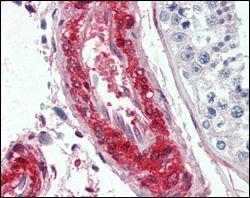IKBKE Antibody
Purified Mouse Monoclonal Antibody
- 产品详情
- 实验流程
Application
| WB, E |
|---|---|
| Primary Accession | Q14164 |
| Reactivity | Human |
| Host | Mouse |
| Clonality | Monoclonal |
| Clone Names | 6B4B5 |
| Isotype | IgG1 |
| Calculated MW | 80462 Da |
| Description | Inhibitor of kappa light polypeptide gene enhancer in B-cells, kinase epsilon.The transcription factor NFκB is retained in the cytoplasm in an inactive form by the inhibitory protein IκB. Activation of NFκB requires that IκB be phosphorylated on specific serine residues, which results in targeted degra-dation of IκB. IκB kinase α(IKKα), previously designated CHUK, interacts with IκB-αand specifically phosphorylates IκB-αon the sites that trigger its degradation, serines 32 and 36. The functional IKK complex contains three subunits, IKKα, IKKβand IKKγ(also designated NEMO), and each appear to make essential contributions to IκB phosphorylation. IKK-i is a serine/threonine kinase that shares homology with IKKαand IKKβ. IKK-i is pri-marily expressed in immune cells and is induced by lipopolysaccharide and by proinflammatory cytokines including TNFα, IL-1 and IL-6. Overexpression of IKK-i was shown to result in phosphorylation of IκBαon Ser32 andSer36, and in NFκB activation, suggesting that IKK-i may act as an IκB kinase in the immune system. |
| Immunogen | Purified recombinant fragment of IKBKE (aa1-257) expressed in E. Coli. |
| Formulation | Ascitic fluid containing 0.03% sodium azide. |
| Gene ID | 9641 |
|---|---|
| Other Names | Inhibitor of nuclear factor kappa-B kinase subunit epsilon, I-kappa-B kinase epsilon, IKK-E, IKK-epsilon, IkBKE, 2.7.11.10, Inducible I kappa-B kinase, IKK-i, IKBKE, IKKE, IKKI, KIAA0151 |
| Dilution | WB~~1/500 - 1/2000 E~~N/A |
| Storage | Maintain refrigerated at 2-8°C for up to 6 months. For long term storage store at -20°C in small aliquots to prevent freeze-thaw cycles. |
| Precautions | IKBKE Antibody is for research use only and not for use in diagnostic or therapeutic procedures. |
| Name | IKBKE |
|---|---|
| Synonyms | IKKE, IKKI, KIAA0151 |
| Function | Serine/threonine kinase that plays an essential role in regulating inflammatory responses to viral infection, through the activation of the type I IFN, NF-kappa-B and STAT signaling. Also involved in TNFA and inflammatory cytokines, like Interleukin-1, signaling. Following activation of viral RNA sensors, such as RIG-I- like receptors, associates with DDX3X and phosphorylates interferon regulatory factors (IRFs), IRF3 and IRF7, as well as DDX3X. This activity allows subsequent homodimerization and nuclear translocation of the IRF3 leading to transcriptional activation of pro-inflammatory and antiviral genes including IFNB. In order to establish such an antiviral state, IKBKE forms several different complexes whose composition depends on the type of cell and cellular stimuli. Thus, several scaffolding molecules including IPS1/MAVS, TANK, AZI2/NAP1 or TBKBP1/SINTBAD can be recruited to the IKBKE-containing-complexes. Activated by polyubiquitination in response to TNFA and interleukin-1, regulates the NF-kappa-B signaling pathway through, at least, the phosphorylation of CYLD. Phosphorylates inhibitors of NF-kappa-B thus leading to the dissociation of the inhibitor/NF-kappa-B complex and ultimately the degradation of the inhibitor. In addition, is also required for the induction of a subset of ISGs which displays antiviral activity, may be through the phosphorylation of STAT1 at 'Ser-708'. Phosphorylation of STAT1 at 'Ser-708' also seems to promote the assembly and DNA binding of ISGF3 (STAT1:STAT2:IRF9) complexes compared to GAF (STAT1:STAT1) complexes, in this way regulating the balance between type I and type II IFN responses. Protects cells against DNA damage-induced cell death. Also plays an important role in energy balance regulation by sustaining a state of chronic, low-grade inflammation in obesity, wich leads to a negative impact on insulin sensitivity. Phosphorylates AKT1. |
| Cellular Location | Cytoplasm. Nucleus. Nucleus, PML body. Note=Targeting to PML nuclear bodies upon DNA damage is TOPORS-dependent (PubMed:20188669) Located diffusely throughout the cytoplasm but locates to punctate cytoplasmic bodies when coexpressed with TRIM6 (PubMed:24882218) |
| Tissue Location | Highly expressed in spleen followed by thymus, peripheral blood leukocytes, pancreas, placenta. Weakly expressed in lung, kidney, prostate, ovary and colon |
Research Areas
For Research Use Only. Not For Use In Diagnostic Procedures.
Application Protocols
Provided below are standard protocols that you may find useful for product applications.
REFERENCES
1. Cell. 2007 Jun 15;129(6):1065-79. 2. Mol Syst Biol. 2007;3:89. Epub 2007 Mar 13. 3. Arthritis Rheum. 2007 Mar;56(3):743-52.
终于等到您。ABCEPTA(百远生物)抗体产品。
点击下方“我要评价 ”按钮提交您的反馈信息,您的反馈和评价是我们最宝贵的财富之一,
我们将在1-3个工作日内处理您的反馈信息。
如有疑问,联系:0512-88856768 tech-china@abcepta.com.























 癌症的基本特征包括细胞增殖、血管生成、迁移、凋亡逃避机制和细胞永生等。找到癌症发生过程中这些通路的关键标记物和对应的抗体用于检测至关重要。
癌症的基本特征包括细胞增殖、血管生成、迁移、凋亡逃避机制和细胞永生等。找到癌症发生过程中这些通路的关键标记物和对应的抗体用于检测至关重要。 为您推荐一个泛素化位点预测神器——泛素化分析工具,可以为您的蛋白的泛素化位点作出预测和评分。
为您推荐一个泛素化位点预测神器——泛素化分析工具,可以为您的蛋白的泛素化位点作出预测和评分。 细胞自噬受体图形绘图工具为你的蛋白的细胞受体结合位点作出预测和评分,识别结合到自噬通路中的蛋白是非常重要的,便于让我们理解自噬在正常生理、病理过程中的作用,如发育、细胞分化、神经退化性疾病、压力条件下、感染和癌症。
细胞自噬受体图形绘图工具为你的蛋白的细胞受体结合位点作出预测和评分,识别结合到自噬通路中的蛋白是非常重要的,便于让我们理解自噬在正常生理、病理过程中的作用,如发育、细胞分化、神经退化性疾病、压力条件下、感染和癌症。







